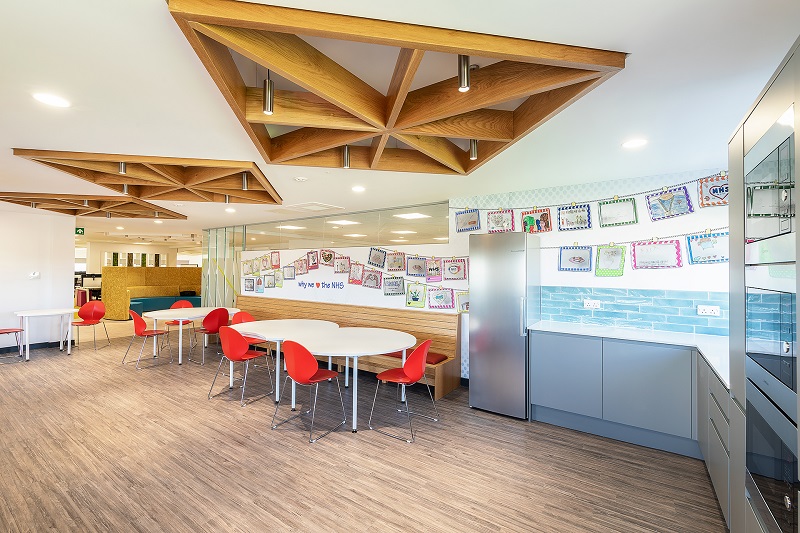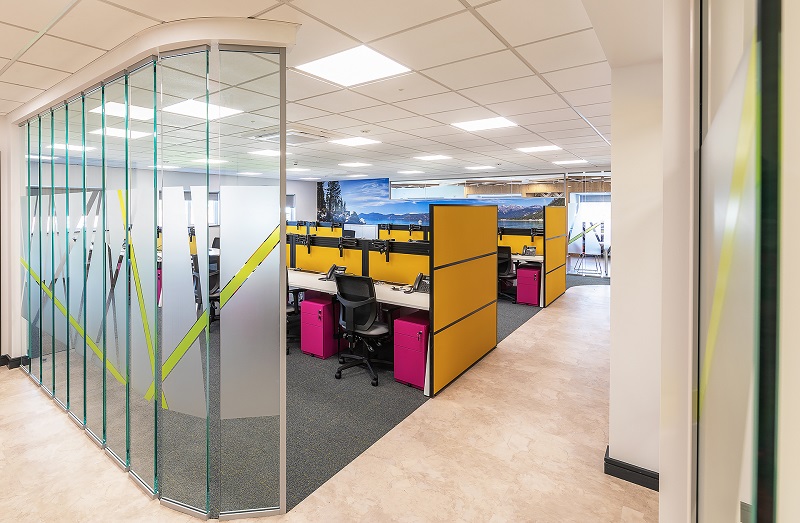The need to put patients at the heart of healthcare design is widely accepted.
But sometimes the impact these buildings have on the people who work in them day in, day out, is somewhat overlooked.
Now a flagship project at Hull Royal Infirmary is changing that – and putting staff right at its heart.
Under one roof
Suite 36 is a second-floor office development aimed at creating space for a plethora of health and wellbeing services, including Hull City Council and East Riding of Yorkshire Council, social workers, Humber mental health team, corporate nursing, patient experience staff, and a call centre for patient referrals.
As trust staff spend most of their time indoors, the initial brief was to create a working environment with high specification which is accessible, sustainable, and stimulating for staff to enjoy and feel proud to work in
Half the staff are from partnering organisations outside of the trust, with the bulk supporting the complex process of patient discharge to both home or social care services, in turn enabling the hospital to function and take in new patients.
This wide mix of stakeholders meant one design would not suit all, and so the project has been built around defining spaces and building in future flexibility.
Speaking to BBH architect, Alessandro Caruso of ACA, explains: “Suite 36 was part of Hull University Teaching Hospitals NHS Trust’s estate rationalisation programme, with the aim of improving efficiency and enhancing work environments for clinical teams.
“As trust staff spend most of their time indoors, the initial brief was to create a working environment with high specification which is accessible, sustainable, and stimulating for staff to enjoy and feel proud to work in.”
The scheme, which was created in conjunction with Zenith Development Group as part of a design-based competition and comprises approximately 900sqm of open-plan office space for 120 workstations, including video conferencing facilities, meeting rooms, and all associated accommodation.
Breaking down space
For the project, Caruso made use of design principals contained in WELL Building Standards, which favour a simple layout with efficient circulation spaces, aesthetically-appealing interiors, and motivating environments which holistically support health and wellbeing.
For example, elements of biophilic design were used, including a ‘living wall’.
And, while this feature looks appealing for office users; there is also a much-deeper reason for including it in the space, with studies showing that adding biophilic elements to offices can increase productivity and reduce sickness rates, a key problem for the NHS.
Just because you start with a model of clusters and a need for privacy in some areas, does not mean that will continue to be the case for the life of the building, so you need to build in flexibility
In a similar vein, artwork and graphics which help to further define spaces were very carefully chosen.
Stakeholder feedback sessions led to a shift away from the traditional choice of local landmarks as the inspiration for integral artworks.
This was due to the presence of mental health teams within the building and the associations between significant local landmarks such as the Humber Bridge and the Humber River and suicide.
Instead, more-generic graphics were used to achieve the feeling that workers are not in a clinical hospital environment.
Caruso explains: “The trust was sensitive about creating an environment that was particularly nice.
“It was about breaking down the space to accommodate different user groups and to acknowledge a need for focused work areas and a place where people could get away from their desks.
“We have considered each area and given it individual characteristics, either by colour of type of seating, for example.
“In this way everyone feels that, despite it being open plan, there is a sense of ownership and identification of the area each person is working in.”

Construction work took 11 weeks and the project incorporates a variety of energy-saving innovations
Flexible for the future
Furniture chosen was of a modular design which allows various groupings to suit each area.
And rooms have been designed to be flexible so if groups expand or contract the space can accommodate this in the future.
As well as concentrating on the offices, recreational space was also integral to the design.
“Just because you start with a model of clusters and a need for privacy in some areas, does not mean that will continue to be the case for the life of the building, so you need to build in flexibility”, said Caruso.
And there are a number of refreshment and break-out spaces within the design so staff can move away from their desks.
Construction of the new office took 11 weeks at a cost of £875,000.
And the project incorporates a number of energy-saving elements. These include:
- Wall heights and ceiling layouts were chosen to accommodate standard-sized products, thereby mitigating waste
- Insulated walls reduce noise and regulate temperature
- LED fittings reduce energy usage and give a longer lifecycle, also bringing cost savings to the trust in terms of maintenance
- Lighting closer to the perimeter has in-built photo cells with units individually self-dimming in conditions where natural light negates the need for artificial light
- Sanitaryware is fitted with flow control restrictors, including waterless urinals, to reduce water consumption
- The lift features NGV valve control, which prevents overheating and therefore energy wastage
- Underfloor power distribution feeds into individual floor boxes and a ‘powertrack’ busbar can be used for future connections
- Quooker taps are installed in kitchen area to save water and energy compared with kettles
But, one of the biggest savings has been on overall floor space and the reduction of single or shared offices.
Making savings
This is also the main facilitator for the emptying of the trust’s Wilson Building and its planned demolition to make way for a new clinical development.
The Wilson building is 1,530sqm in area and has a backlog maintenance requirement of £327,000 to bring it up to date.
The new facility has no backlog maintenance requirement and is only 900sqm, the equivalent of an overall saving in space of 630sq m.
Staff now enjoy functional, zoned spaces that provide a healthy environment, increasing the wellbeing and productivity of the workforce
In addition to this, figures received by Zenith show additional space savings of 545.2sq m based on the floor space used by the other teams which have moved into, or are due to move into, the development.
Calum Preston of Zenith Development Group, comments: “The people who save lives; piece lives back together; support families in their time of need; provide dignity and care at the end of life - these are the people we had in mind when designing and realising Suite 36.
“The people who do all these things, and more, deserve spaces in which they can work comfortably and be inspired.
“And, with estate rationalisation a key priority for the NHS, the Suite 36 project embodies the theory behind it.
“But it goes beyond just freeing up space for NHS use. We wanted to give the staff more than they expected and to support the culture of care.”

The open-plan feel to the space provides work areas together with carefully-design recreational spaces
Increasing productivity
He added: “Staff now work in modern, functional, high-spec spaces, which are accessible, sustainable and stimulating.
“They feel proud of their working environment, whether they are working at their desks, grabbing a coffee in the kitchen area, or coming together in one of the inspiring meeting rooms.
“The brief solved the problems staff faced before, namely a lack of storage; departments working remotely and individually; dated office environments that were no longer fit for purpose; and non-descript spaces.
“They now enjoy functional, zoned spaces that provide a healthy environment, increasing the wellbeing and productivity of the workforce.”
